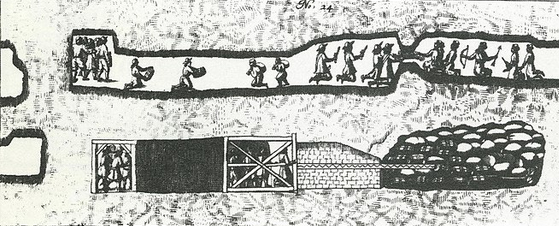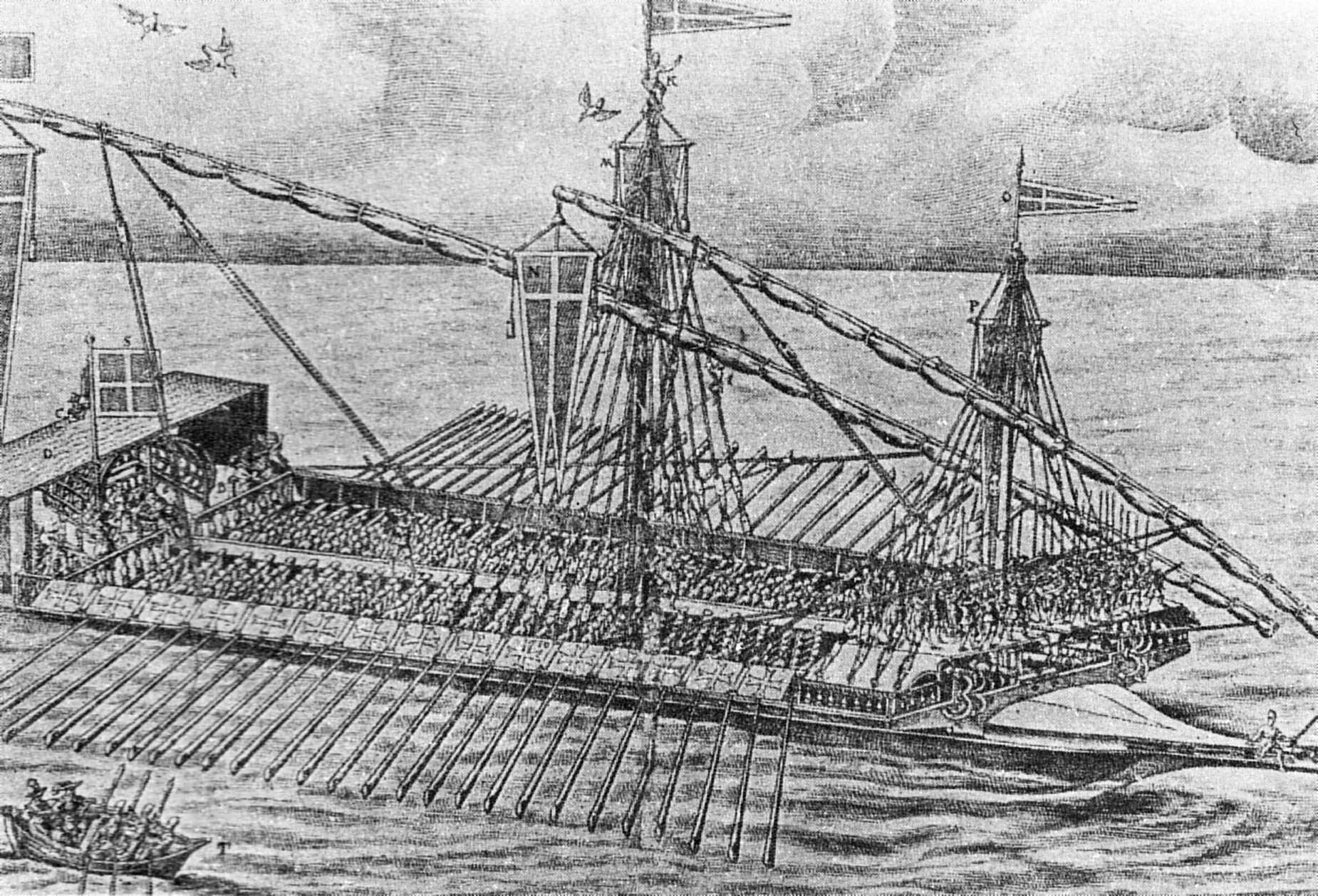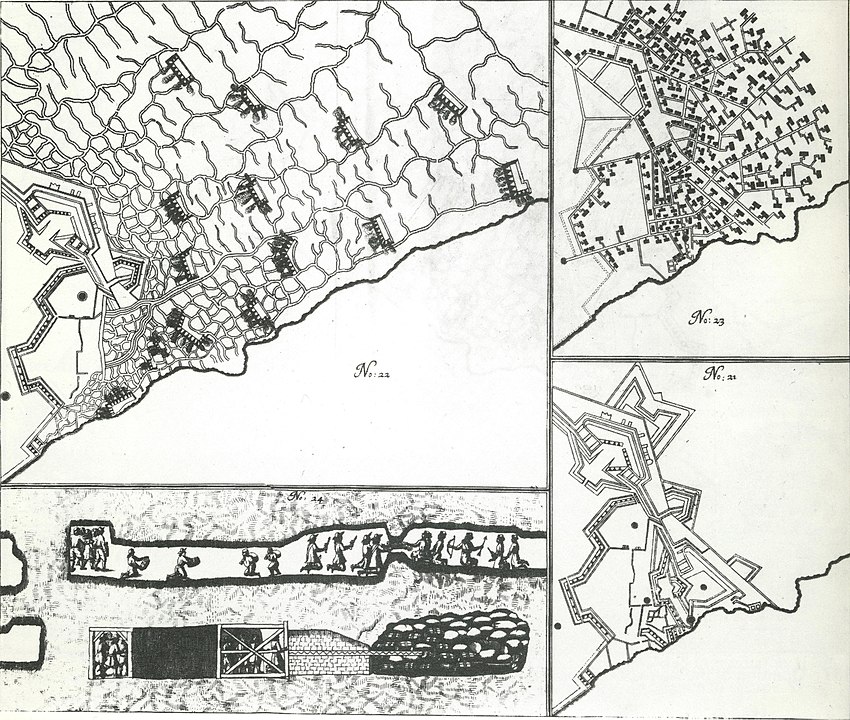By 1669 CE it was already clear that the big profits and big power in world affairs were accruing to nations that could create and sustain capable transoceanic empires, the prerequisites for which were:
- large, capable fleets of trans-oceanic ships that had the dual capabilities of carrying cargo and being able to fight defensively and offensively (naval gunnery!);
- the ability to maintain trading posts in various port cities around the world– either through arrangement with and under the protection of capable local authorities, or by force as necessary;
- the ability to staff all aspects of the imperial/colonial venture including to populate and work in the distant colonies, whether through transportation of enslaved (non-national) persons, transportation of nationals judged “criminals” or those economically stressed enough to accept to be “indentured”, or mobilization of colonists on religious grounds;
- the ability to understand, administer, and as needed regulate and control all the different parts of the nation’s colonial/imperial project;
- the ability to finance it on a continuing basis.
By 1669, four powers had enough of these capabilities to have built global empires (though in varying proportions): Portugal, Spain, the Dutch United Provinces, and England. But the balance among them was shifting– and Louis XIV’s France was waiting in the wings, battling the UPs at home and continuing to prepare for further forays into colony-building in the Indian Ocean, the Caribbean, North America and the Indian Ocean.
In 1669, the four imperial powers continued to run, staff, defend, and where possible expand their global empires. Keep that big-picture background in mind as I review four other significant developments in the world of 1669: two concerning issues in bodies of water much smaller than the world’s great oceans (and blocked to a significant degree from easy access to them) and two concerning the era’s large land-based empires. Let’s take the “smaller bodies of water” developments first:
The Hanseatic League winds up its work

The Hanseatic League had been a kind of transnational guild of “free” cities throughout the Baltic and the Low Countries that since the late 12th century CE had had both commercial and defensive functions. The status of a “free” city was one that initially gave them some affiliation to the Spanish Habsburgs– but directly, without the mediation of any more powerful local nobles; and that allowed them to trade very freely with each other and with other cities to the east. This (slightly contested) page on WP tells us this about its origins:
Historians generally trace the origins of the Hanseatic League to the rebuilding of the north German town of Lübeck in 1159 by the powerful Henry the Lion, Duke of Saxony and Bavaria, after he had captured the area… German cities achieved domination of trade in the Baltic with striking speed during the 13th century, and Lübeck became a central node in the seaborne trade that linked the areas around the North and Baltic seas. The hegemony of Lübeck peaked during the 15th century.
The page notes that the League grew a lot in the 13th century, noting crucially that, “Much of the drive for this co-operation came from the fragmented nature of existing territorial governments, which failed to provide security for trade.”
The WP page continued:
Most foreign cities confined the Hanseatic traders to certain trading areas and to their own trading posts. They seldom interacted with the local inhabitants, except when doing business. Many locals, merchant and noble alike, envied the power of the League and tried to diminish it. For example, in London, the local merchants exerted continuing pressure for the revocation of privileges. The refusal of the Hansa to offer reciprocal arrangements to their English counterparts exacerbated the tension…
[I]ts eventual rivals emerged in the form of the territorial states, whether new or revived, and not just in the west: Ivan III, Grand Prince of Moscow, ended the entrepreneurial independence of Hansa’s Novgorod Kontor in 1478—it closed completely and finally in 1494. New vehicles of credit were imported from Italy, where double-entry book-keeping was invented in 1492, and outpaced the Hansa economy, in which silver coins changed hands rather than bills of exchange.

To the causes of the decline of the Hansa I would certainly add– and this happened in conjunction with the emergence of a number of substantial territorial states on Europe’s western seaboard– the emergence of those states’ transoceanic empires. From the mid 15th century onwards, access to oceanic lines of communication was becoming much more important (and profitable) than access among the littoral states of the Baltic and the North Seas.
Anyway, this happened:
By the late 17th century, the league had imploded and could no longer deal with its own internal struggles… In 1666, the Hanseatic Steelyard [trading center] in London burned down by the Great Fire of London. The Kontor-manager sent a letter to Lübeck appealing for immediate financial assistance for a reconstruction. Hamburg, Bremen and Lübeck called for a Hanseatic Day in 1669. Only a few cities participated and those who came were very reluctant to contribute financially to the reconstruction, it was the last formal meeting.
Ottoman military completes its occupation of Crete
This was a notable development in the power-balance in the eastern Mediterranean. The Ottoman Navy had been occupying most of Crete since 1648 but they just could not capture its fortified capital city Candia (today’s Heraklion), which was still held by the Venetians.) So for 21 years the Ottomans on land had besieged the Venetians in the city, while the Venetians in the surrounding waters had been trying to isolate and cut off the Ottomans on the rest of Crete from their homeland.
In 1664, the Ottomans had ended a long-running war they’d been fighting in the north, against the Hungarians, and their powerful Grand Vizier Köprülü Fazıl Ahmed was thereafter ready to concentrate on Crete. In May 1667, he personally led what was described as “the final stage” of the siege of Candia. WP tells us this: “It lasted 28 months. In the… sorties that followed, 108,000 Turks and 29,088 Christians lost their lives.”
Wow. That was punishing. WP notes this:
The surrender of Candia ended the four and a half centuries of Venetian rule in Crete, and brought the Ottoman Empire to its temporary territorial zenith. At the same time, the cost and casualties incurred during this prolonged war contributed greatly to the decline of the Ottoman state during the latter 17th century. On the other hand, Venice had lost its greatest and most prosperous colony, its pre-eminent trading position in the Mediterranean had diminished, and its treasury was exhausted, having spent some 4,253,000 ducats on the defense of Candia alone… Crete would remain under Ottoman control until 1897, when it became an autonomous state.
Aurangzeb faces a new Hindu uprising
The grandfather and father of the Mughal Emperor Aurangzeb had distinguished themselves by the religious toleration and inclusiveness with which they ruled. Aurangzeb was not inclined to do the same. An apparently fervent Muslim, he had been cracking down on Hindu institutions throughout his empire for some years.
In 1669 he took a notable new step in this campaign. WP tells us that, “In September 1669, he ordered the destruction of Vishvanath Temple at Varanasi, which was established by Raja Man Singh, whose grandson Jai Singh was believed to have facilitated Shivaji’s escape.” (Shivaji, you will recall, was the wily leader of a recent rebellion by the Hindu Marathas, who had sacked the wealthy Mughal city of Surat in 1664.)
Then, also in 1669, this happened:
In 1669, Hindu Jats began to organise a rebellion that is believed to have been caused by the re-imposition of jizya and destruction of Hindu temples in Mathura. The Jats were led by Gokula, a rebel landholder from Tilpat. By the year 1670, 20,000 Jat rebels were quelled and the Mughal Army took control of Tilpat, Gokula’s personal fortune amounted to 93,000 gold coins and hundreds of thousands of silver coins.
China’s emperor allows return of subjects displaced from coast
Back in 1661, when the pro-Ming warlord Koxinga was retreating from mainland China to take up residence on Taiwan, China’s newly arrived Qing emperor, the Shunzhi Emperor had decreed that all residents of the coastal Xin’an County (which covered roughly the territory of modern-day Shenzhen and Hong Kong) and adjacent counties of Guangdong must leave their homes. This was, in a sense, a version of the “strategic hamlets” doctrine employed by many imperial powers, since the Qing emperor’s goal was to remove Koxinga’s ability to have any supporters close at hand to give aid to his navies.
Some 16,000 residents of the coastal areas were expelled from their homes and lands and displaced into the Chinese interior. English-WOP tells us this:
The ban was lifted in 1669… Only 1,648 of those who left are said to have returned when the evacuation was rescinded in 1669. When the ban was lifted… the coastal defense was reinforced. Twenty-one fortified mounds, each manned with an army unit, were created along the border of Xin’an County, and at least five of them were located in present-day Hong Kong




